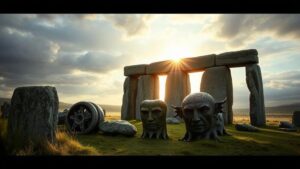Exploring the “Maze of Time,” where explorers claim to encounter echoes of themselves.
Exploring the “Maze of Time”: Encounters with Echoes of Ourselves
The concept of time is often viewed as linear, a straight line that moves from the past into the future. But, various explorers claim to have experienced an extraordinary phenomenon known as the “Maze of Time,” where they encounter echoes of themselves from different points in their lives. This incredible theory draws on elements of quantum physics, time travel, and even psychological introspection. This article explores these claims and the stories that accompany them.
The Origin of the Maze of Time
The “Maze of Time” is a term that surfaced in the early 21st century, primarily following the publication of the book Time and the Multiverse by Dr. Alice Harmon in 2005. Harmon theorized that time does not operate in a straightforward manner but instead exists in a complex web of interconnections between moments. idea gained traction among explorers, philosophers, and scientists.
In 2010, a group of adventurers known as the Temporal Explorers embarked on a journey into a remote area of the Appalachian Mountains in the United States, specifically near the mysterious Brown Mountain, known for its unusual lights and strange occurrences. The terrain itself was dubbed the “Maze of Time” by the explorers after they allegedly encountered echoes of their past selves, which sparked public interest and debate around the physical and metaphysical implications of such experiences.
Encounters and Experiences
According to explorers who ventured into the Maze of Time, their experiences often involved profound self-reflection and perplexing interactions with their past selves. For example, one explorer, John Harrington, reported seeing a younger version of himself during a particular moment of regret in his life. He described the encounter as “an emotional confrontation with choices that had long since passed.”
These echoes are said to appear as phantoms or visions, enabling explorers to engage with past emotions and decisions. Another familiar account includes Maria Vasquez, who claimed she witnessed her teenage self during a stressful time related to family issues. She noted, “It felt like I was looking into a mirror, but the reflection was grappling with unresolved pain that I had buried deep inside.”
The Science Behind the Phenomenon
The puzzle of time travel and parallel universes has situated itself among theoretical physicists. Quantum mechanics posits the existence of alternate realities, where every decision creates a branching timeline. Theories from physicists such as Hugh Everett III and his Many-Worlds Interpretation suggest that for every event, there are multiple outcomes, leading to parallel universes where alternate selves exist.
- In 1957, Hugh Everett III introduced his Many-Worlds Interpretation in his doctoral dissertation.
- In 1991, research into time dilation effects began to emerge due to advancements in space exploration, particularly with the Global Positioning System (GPS).
While these scientific explorations do not directly claim the existence of a “Maze of Time,” they lay the groundwork for the exploration of such phenomena. The intertwining of theoretical physics with human experience raises potent questions about the nature of reality and existence.
Real-World Applications
The concept of the Maze of Time, while largely anecdotal, offers exciting insights into psychological recovery and emotional healing. apeutic techniques, such as guided imagery and regression therapy, can allow individuals to confront past traumas by visualizing interactions with younger versions of themselves. This can potentially facilitate personal growth and healing.
Organizations focusing on mental health have begun using similar concepts to help clients perform deep introspection. Cognitive Behavioral Therapy (CBT) utilizes the principle of recognizing and challenging distortions in thoughts to reshape perceptions of self and reality. Exploring ones past can be a transformative exercise, helping individuals navigate their mental landscapes much like travelers through a maze.
Conclusion: Actionable Takeaways
While the awe-inspiring claims about the Maze of Time remain controversial and unexplained scientifically, they invite intriguing discussions about time, self-reflection, and healing. Here are some actionable takeaways:
- Consider journaling about pivotal moments in your life; reflect on how those experiences shape who you are today.
- Explore guided imagery or regression therapy if youre seeking to confront past traumas; professional therapists can help navigate this journey.
- Engage in discussions about time with peers or in forums focused on philosophy and science; understanding different perspectives can enrich your comprehension of these complex subjects.
The exploration of the Maze of Time beckons us to ask deeper questions about who we are and how our past informs our future. Whether real or metaphorical, the echoes we encounter in life can profoundly guide our journeys ahead.


